Planting a Pear Tree: [Care, Irrigation, Soil, Pests and Diseases]
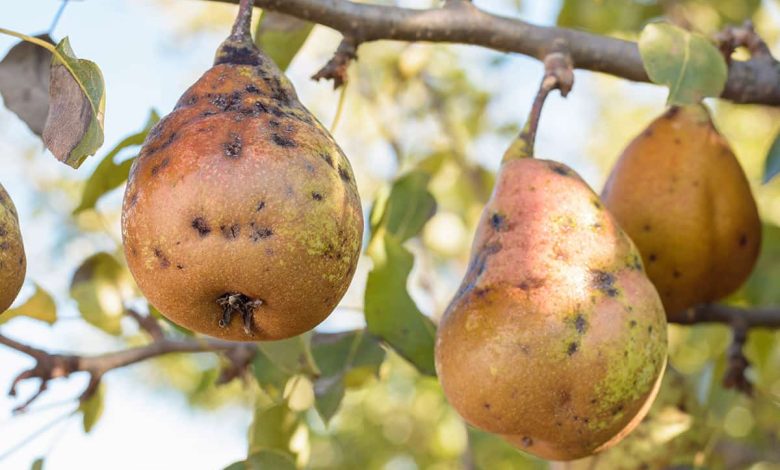
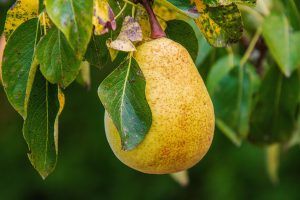 The pear tree and bush (/ˈpɛər/) are a species of the genus Pyrus /ˈpaɪrəs/, of the Rosaceae family, which bears the pome fruit of the same name, pear.
The pear tree and bush (/ˈpɛər/) are a species of the genus Pyrus /ˈpaɪrəs/, of the Rosaceae family, which bears the pome fruit of the same name, pear.
Several species of pears are valued for their edible fruit and juices while others are grown as trees.
The tree is medium in size and is native to coastal and slightly temperate regions of Europe, North Africa and Asia. Pear wood is one of the preferred materials in the manufacture of high-quality woodwind instruments and meat furniture.
Some 3,000 known varieties of pears are grown around the world. The fruit is consumed fresh, canned and dried. In 2017, the world production of pears was 24 million tons, with China being the main producer.
Important points when planting a pear tree
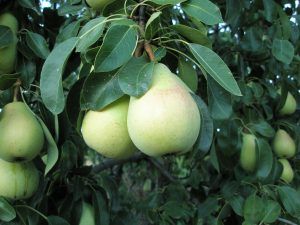 When? In late winter and early spring.
When? In late winter and early spring.- Where? In full sun if possible.
- How do we prepare the land? Generous with a good substrate.
- pH level? Between 3.5 and 4.5.
- How do we water? At first it is advisable to water abundantly, especially in dry or hotter seasons.
- How often do we water? We recommend drip irrigation.
- When is it harvested? At the end of summer.
- What pests and diseases do you have? Brown rot, Pear rust, Pear leaf blister mite.
Pear Characteristics
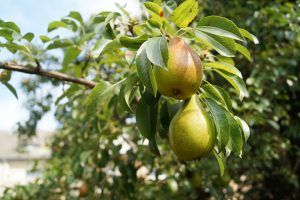 The pear is native to the coastal and mild temperate regions of the Old World, from Western Europe and North Africa to East Asia.
The pear is native to the coastal and mild temperate regions of the Old World, from Western Europe and North Africa to East Asia.
It is a medium-sized tree, reaching 10-17 meters in height, often with a tall, narrow crown ; some species are shrubby.
The leaves are alternately arranged, simple, 2-12 centimeters long, bright green in some species, densely hairy silvery in some others; the shape of the leaves varies from wide oval to narrow lanceolate. Most pears are deciduous, but one or two species from Southeast Asia are evergreen.
Most are cold hardy, withstanding temperatures as low as -25 to -40°C (-13 to -40°F) in winter, except for evergreen species, which only tolerate temperatures down to about -15°C (5°F).
The flowers are white, rarely tinged with yellow or pink, 2 to 4 centimeters in diameter, and have five petals. Like that of the related apple, the fruit of the pear is a pomp, in most wild species 1-4 centimeters in diameter, but in some cultivated forms up to 18 centimeters long and 8 centimeters wide.
Shape varies in most species from oblique or globose, to the classic pyriform «pear-shaped» of the European pear with an elongated basal portion and a bulbous tip. To know more, read: Varieties of pears.
Where to plant a pear tree?
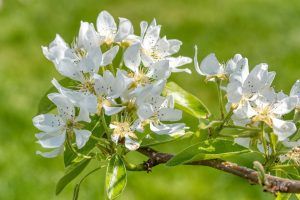 Pears require full sun.
Pears require full sun.
Make sure you choose a spot that gets at least six to eight hours of sun, not only for your tree but for the fruit as well.
Pear tree care will be easier if you plan ahead.
How to water a pear tree
Pear trees, when planted either from seed or seedling, require substantial amounts of water.
Once they reach maturity (after a few years), their water needs drop considerably.
Points to consider:
- If you plant your pear tree in summer, they will need a lot of water and there is a high risk that they will end up drying out.
- If you plant it in winter, they will also need water if it doesn’t rain, but obviously the humidity will favor their survival.
- Once the pear tree is adult, it will not require as much water and will be able to endure many days without being watered.
Our favorite option for watering pear trees is drip irrigation.
How to plant a pear tree step by step?
- Dig a hole wide and deep, mixing a large amount of compost into the ground (manure, compost, substrate…).
- Take the tree out of its container, including the burlap, and put it in the hole to the same depth as it was in its container.
- Gently spread out the roots and fill the hole with the potting soil.
- Water well and continue to water regularly – once or twice a week – until the roots are well established.
- Knowing how to plant a pear tree is not enough. An important part of pear tree care is pruning, and the first pruning should be done as soon as the tree is planted.
- Leave a central leader and choose three to five branches growing out rather than up and prune the rest. Trim the ends of the remaining branches to encourage growth.
- There are many books and articles written on pruning, but for the home gardener, pruning care for pear trees may be limited to removing cross branches and fast-growing upgrowth.
- Your pear tree will bear fruit in three to five years.
pear tree pruning
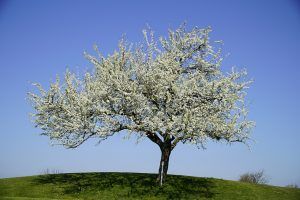 Prune annually to keep the tree healthy. For dwarf trees, prune them back to a central leader system.
Prune annually to keep the tree healthy. For dwarf trees, prune them back to a central leader system.
Standard-size trees can be pruned to a central leader system or a modified leader system, which is easier to maintain.
The central training system has a central trunk with branches that spiral out every 20-50 centimeters, making sure that no branch is directly on top of another.
Training for such a system begins in the early summer of the first year, during which time any shoots that form less than 18 inches from the ground should be removed.
The end result should resemble a Christmas tree.
pear harvest
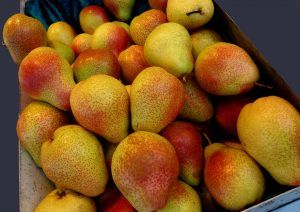 It’s always hard to wait for something good, but waiting often improves the experience. This is the case of pears.
It’s always hard to wait for something good, but waiting often improves the experience. This is the case of pears.
Pears do not ripen best on the tree. They ripen from the inside out and develop soft interiors with a soft, grainy texture.
Pears should be firm and juicy for best results whether eaten by hand or canned. Farmers know how to pick pears and when they are ready for use.
According to professional growers, pears should be allowed to ripen on the tree rather than on the stem. This is because the pears will develop too much on the vine, resulting in a soft texture and too sugary flesh.
If you pick pears when they have sweetly flushed skin but are still firm and slightly underripe, you can ripen them at home or in a paper bag for a week.
The delicious flavor will be obtained after a week and the fruit will reach its best texture.
Pear tree care
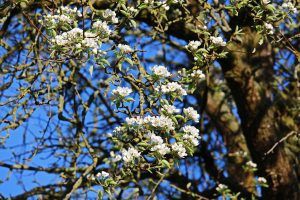 Compared to other fruits, pear tree care is simple and straightforward.
Compared to other fruits, pear tree care is simple and straightforward.
They don’t suffer from as many disease or insect problems, so they are easier to grow.
stake in the trunk
Pear tree care begins right after planting. Pears should be staked with a sturdy stake driven into the ground to help the tree grow straight and resist wind damage.
Mulch
Mulch 5-7.5cm deep in a wide enough circle around the tree to prevent weeds from robbing the tree of nutrients and water.
Fertilization
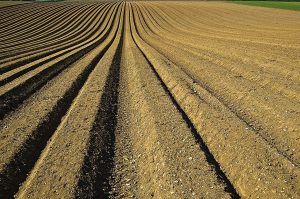 Unless your soil is extremely poor, fertilizing once a year should be enough for your pear tree. In fact, care must be taken to avoid overfertilization, which produces a very beautiful and ornamental tree, but without fruits.
Unless your soil is extremely poor, fertilizing once a year should be enough for your pear tree. In fact, care must be taken to avoid overfertilization, which produces a very beautiful and ornamental tree, but without fruits.
Insects and pesticides: not recommended
Some gardeners will insist that spraying insecticides and oil just before buds come into bloom are essential for proper pear tree care. We do not think so, although we are not necessarily against its use.
As stated before, pears have fewer insect problems than other fruits. One of the reasons for this is the nectar of its flowers, which is not as attractive to insects as other fruits; and since bees are the main pollinators of pear trees, care must be taken not to drive them away or, worse yet, kill them.
If your first crop, which is usually small and often inedible, is badly damaged, you’ll have plenty of time to re-evaluate it before the next season.
Pear tree pests and diseases
brown rot
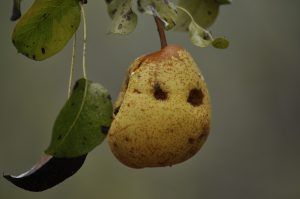 Brown rot is a fungal disease that causes a brown, spreading rot on the fruit, sometimes with white fungal pustules on the surface.
Brown rot is a fungal disease that causes a brown, spreading rot on the fruit, sometimes with white fungal pustules on the surface.
It is usually worse in humid summers.
Remedy: Remove all rotten fruit as soon as you see it and destroy it, this will prevent the spread of rot.
pear rust
Rusty Pear: Pear rust is a disease that causes bright orange spots on the upper leaf surfaces of pear trees in summer and early fall.
Remedy: Remove all infected leaves as soon as you see them and destroy them, this will prevent the spread of rust. There is no chemical control.
Pear leaf blister mite
This mite is a common problem on pear leaves, causing yellow or red blisters that eventually turn black. The damage is unsightly but does not affect the crop.
Remedy: There is no control other than removal of damaged leaves.

How long does the pear tree live?
The lifespan of a pear tree is variable depending on the conditions in which it is planted, ranging from 50 to 400 years.
How long does it take to grow the pear tree?
The pear tree occupies the first 7 years of life developing its structure to go from its juvenile to the adult phase.
How long does it take to produce fruit?
It begins to produce fruit at 4 years and can maintain a favorable productive rate until it is approximately 40 years old.
Can it be grown in a pot?
The pear tree is a fruit tree that accepts planting in a pot and is capable of producing without problems.
How many times does the pear tree produce fruit?
Pear fruit production is annual and occurs in the period from summer to autumn.
Should the pear tree be pollinated to obtain fruit?
Pollination must be carried out and this work is produced thanks to the action of the bees that are responsible for carrying the pollen from flower to flower.
How cold can the pear tree tolerate?
When the pear tree is in its winter lethargy phase, it is extremely resistant to frost and is capable of reaching -40°C.
How many pear trees can be planted per hectare?
Pear trees have a structure that makes it possible to plant 600 to 800 trees per hectare.
How much heat and/or drought can the pear tree tolerate?
It is not very heat resistant, as it prefers cool summers. Temperatures above 28° C can make you suffer.
It can withstand small periods of drought, but it is not as tolerant of these conditions.


![Photo of Saffron Pests and Diseases: [Detection, Causes and Solutions]](https://www.complete-gardening.com/wp-content/uploads/2021/06/azafran_1603475572-390x220.jpg)
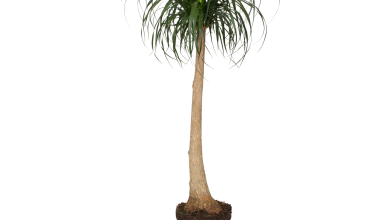
![Photo of Cabbage Baris (Baris spp): [Characteristics, Detection, Effects and Treatment]](https://www.complete-gardening.com/wp-content/uploads/2022/08/cabbage-baris-baris-spp-characteristics-detection-effects-and-treatment-390x220.jpg)